Effects of Mixture Stratification on Combustion and Emissions of Boosted Controlled Auto-Ignition Engines
Abstract
:1. Introduction
2. Research Method and Procedure
2.1. Experimental Test Stand
2.2. Experimental Conditions and Procedure
2.3. Data Analysis
3. Results and Discussion
3.1. Combustion Parameters
3.2. Exhaust Emissions
3.3. Thermal Efficiency
4. Conclusions
- The delay of fuel injection and the resulting increase in mixture stratification advance auto-ignition. Increasing the amount of fuel injected later for stratification also advances auto-ignition. Finally, the results demonstrate that auto-ignition also advances with increasing the excess air by the application of a higher boost pressure. The last effect is presumably a result of the NVO heat release, as some portion of fuel was injected during exhaust re-compression.
- The observed trend in combustion duration is much more complex than that in auto-ignition timing and reveals non-linear effects. The delay of fuel injection up to 300° does not affect the combustion duration to a high extent. A further delay of injection extends the combustion duration. The duration of the combustion process is prolonged by both the amount of fuel injected late and the global excess air ratio.
- Considering the above, fuel stratification could be effective in reducing the PRR provided that the end of compression temperature is reduced as well. This can be done by reducing the NVO fuel or the amount of trapped residuals.
- The emissions of CO, unburned HC and soot depend on the degree of mixture stratification. The delay of fuel injection beyond the threshold of 310–320° results in a dramatic increase in the emissions. This is presumably a result of piston wetting by the fuel stream.
- The emissions of NOX are substantially affected by fuel dilution. The increase in excess air reduces the emissions. With increasing the 3rd injection fuel dose the NOX emissions increase too, even for early injection. The maximum NOX emissions occur for the injection timing of 300–310°, where the highest peak HRRs are observed.
Acknowledgments
Author Contributions
Conflicts of Interest
References
- Lavy, J.; Dabadie, J.; Angelberger, C.; Duret, P.; Willand, J.; Juretzka, A.; Schäflein, J.; Ma, T.; Lendresse, Y.; Satre, A.; et al. Innovative Ultra-Low NOx Controlled Auto-Ignition Combustion Process for Gasoline Engines: The 4-SPACE Project; SAE Technical Paper; No. 2000-01-1837; SAE International: Warrendale, PA, USA, 2000. [Google Scholar] [CrossRef]
- Zhao, H.; Li, J.; Ma, T.; Ladommatos, N. Performance and Analysis of a 4-Stroke Multi-Cylinder Gasoline Engine with CAI Combustion; SAE Technical Paper; No. 2002-01-0420; SAE International: Warrendale, PA, USA, 2002. [Google Scholar] [CrossRef]
- Yao, M.; Zheng, Z.; Liu, H. Progress and recent trends in homogeneous charge compression ignition (HCCI) engines. Prog. Energy Combust. Sci. 2009, 35, 398–437. [Google Scholar] [CrossRef]
- Shi, Y.; Reitz, R.D. Optimization of a heavy-duty compression-ignition engine fuelled with diesel and gasoline-like fuels. Fuel 2010, 89, 3416–3430. [Google Scholar] [CrossRef]
- Onishi, S.; Jo, S.H.; Shoda, K.; Jo, P.D.; Katao, S. Active Thermo-Atmosphere Combustion (ATAC)—A New Combustion Process for Internal Combustion Engines; SAE Technical Paper; No. 790501; SAE International: Warrendale, PA, USA, 1979. [Google Scholar] [CrossRef]
- Noguchi, M.; Tanaka, Y.; Tanaka, T.; Takeuchi, Y. A Study on Gasoline Engine Combustion by Observation of Intermediate Reactive Products During Combustion; SAE Technical Paper; No. 790840; SAE International: Warrendale, PA, USA, 1979. [Google Scholar] [CrossRef]
- Najt, P.; Foster, D. Compression-Ignited Homogeneous Charge Combustion; SAE Technical Paper; No. 830264; SAE International: Warrendale, PA, USA, 1983. [Google Scholar] [CrossRef]
- Hunicz, J.; Krzaczek, P. Detailed speciation of emissions from low temperature combustion in a gasoline HCCI engine. Pol. J. Environ. Stud. 2016, 25, 137–145. [Google Scholar] [CrossRef]
- Hasan, M.M.; Rahman, M.M.; Kadirgama, K.; Ramasamy, D. Numerical study of engine parameters on combustion and performance characteristics in an n-heptane fueled HCCI engine. Appl. Therm. Eng. 2018, 128, 1464–1475. [Google Scholar] [CrossRef]
- Bansal, G.; Mascarenhas, A.; Chen, J.H. Direct numerical simulations of autoignition in stratified dimethyl-ether (DME)/air turbulent mixtures. Combust. Flame 2015, 162, 688–702. [Google Scholar] [CrossRef]
- Huang, Z.; Li, Z.; Zhang, J.; Lu, X.; Fang, J.; Han, D. Active fuel design—A way to manage the right fuel for HCCI engines. Front. Energy 2016, 10, 14–28. [Google Scholar] [CrossRef]
- Turkcan, A.; Ozsezen, A.N.; Canakci, M. Effects of second injection timing on combustion characteristics of a two stage direct injection gasoline–alcohol HCCI engine. Fuel 2013, 111, 30–39. [Google Scholar] [CrossRef]
- Cairns, A.; Blaxill, H. The Effects of Combined Internal and External Exhaust Gas Recirculation on Gasoline Controlled Auto-Ignition; SAE Technical Paper; No. 2005-01-0133; SAE International: Warrendale, PA, USA, 2005. [Google Scholar] [CrossRef]
- Kulzer, A.; Lejsek, D.; Nier, T. A thermodynamic study on boosted HCCI: Motivation, analysis and potential. SAE Int. J. Engines 2010, 3, 733–749. [Google Scholar] [CrossRef]
- Dec, J.E.; Yang, Y. Boosted HCCI for high power without engine knock and with ultra-low NOX emissions—Using conventional gasoline. SAE Int. J. Engines 2010, 3, 750–767. [Google Scholar] [CrossRef]
- Saxena, S.; Bedoya, I.D. Fundamental phenomena affecting low temperature combustion and HCCI engines, high load limits and strategies for extending these limits. Prog. Energy Combust. Sci. 2013, 39, 457–488. [Google Scholar] [CrossRef]
- Lee, K.; Cho, S.; Kim, N.; Min, K. A study on combustion control and operating range expansion of gasoline HCCI. Energy 2015, 91, 1038–1048. [Google Scholar] [CrossRef]
- Hunicz, J.; Geca, M.S.; Kordos, P.; Komsta, H. An experimental study on a boosted gasoline HCCI engine under different direct fuel injection strategies. Exp. Therm. Fluid Sci. 2015, 62, 151–163. [Google Scholar] [CrossRef]
- Sjöberg, M.; Dec, J.E.; Cernansky, N. Potential of Thermal Stratification and Combustion Retard for Reducing Pressure-Rise Rates in HCCI Engines, Based on Multi-Zone Modeling and Experiments; SAE Technical Paper; No. 2005-01-0113; SAE International: Warrendale, PA, USA, 2005. [Google Scholar] [CrossRef]
- Rothamer, D.A.; Snyder, J.A.; Hanson, R.K.; Steeper, R.; Fitzgerald, R.P. Simultaneous imaging of exhaust gas residuals and temperature during HCCI combustion. Proc. Combust. Inst. 2009, 32, 2869–2876. [Google Scholar] [CrossRef]
- Dec, J.E.; Yang, Y.; Dronniou, N. Boosted HCCI—Controlling pressure-rise rates for performance improvements using partial fuel stratification with conventional gasoline. SAE Int. J. Engines 2011, 4, 1169–1189. [Google Scholar] [CrossRef]
- Yang, D.-B.; Wang, Z.; Wang, J.X.; Shuai, S.-J. Experimental study of fuel stratification for HCCI high load extension. Appl. Energy 2011, 88, 2949–2954. [Google Scholar] [CrossRef]
- Lim, O.T.; Iida, N. The investigation about the effects of thermal stratification in combustion chamber on HCCI combustion fueled with DME/n-Butane using Rapid Compression Machine. Exp. Therm. Fluid Sci. 2012, 39, 123–133. [Google Scholar] [CrossRef]
- Lim, O.T. Investigation of thermal stratification effect on n-Heptane/iso-Octane-Air mixture HCCI combustion. Int. J. Automot. Technol. 2013, 14, 843–855. [Google Scholar] [CrossRef]
- Kwon, O.S.; Lim, O. Effect of boost pressure on thermal stratification in HCCI engine using the multi-zone model. J. Mech. Sci. Technol. 2010, 24, 399–406. [Google Scholar] [CrossRef]
- Kodavasal, J.; Lavoie, G.A.; Assanis, D.N.; Martz, J.B. The effect of diluent composition on homogeneous charge compression ignition auto-ignition and combustion duration. Proc. Combust. Inst. 2015, 35, 3019–3026. [Google Scholar] [CrossRef]
- Lawler, B.; Mamalis, S.; Joshi, S.; Lacey, J.; Guralp, O.; Najt, P.; Filipi, Z. Understanding the effect of operating conditions on thermal stratification and heat release in a homogeneous charge compression ignition engine. Appl. Therm. Eng. 2017, 112, 392–402. [Google Scholar] [CrossRef]
- Li, N.; Xie, H.; Chen, T.; Li, L.; Zhao, H. The effects of intake backflow on in-cylinder situation and auto ignition in a gasoline controlled auto ignition engine. Appl. Energy 2013, 101, 756–764. [Google Scholar] [CrossRef]
- Thongchai, S.; Lim, O. Influence of injection strategy on a compression ignition engine fueled with gasoline. Energy Procedia 2017, 105, 1757–1763. [Google Scholar] [CrossRef]
- Peterson, B.; Ekoto, I.; Northrop, W. Investigation of negative valve overlap reforming products using gas sampling and single-zone modeling. SAE Int. J. Engines 2015, 8, 747–757. [Google Scholar] [CrossRef]
- Hunicz, J. An experimental study into the chemical effects of direct gasoline injection into retained residuals in a homogeneous charge compression ignition engine. Int. J. Engine Res. 2016, 11, 1031–1044. [Google Scholar] [CrossRef]
- Hunicz, J.; Medina, A. Experimental study on detailed emissions speciation of an HCCI engine equipped with a three-way catalytic converter. Energy 2016, 117, 388–397. [Google Scholar] [CrossRef]
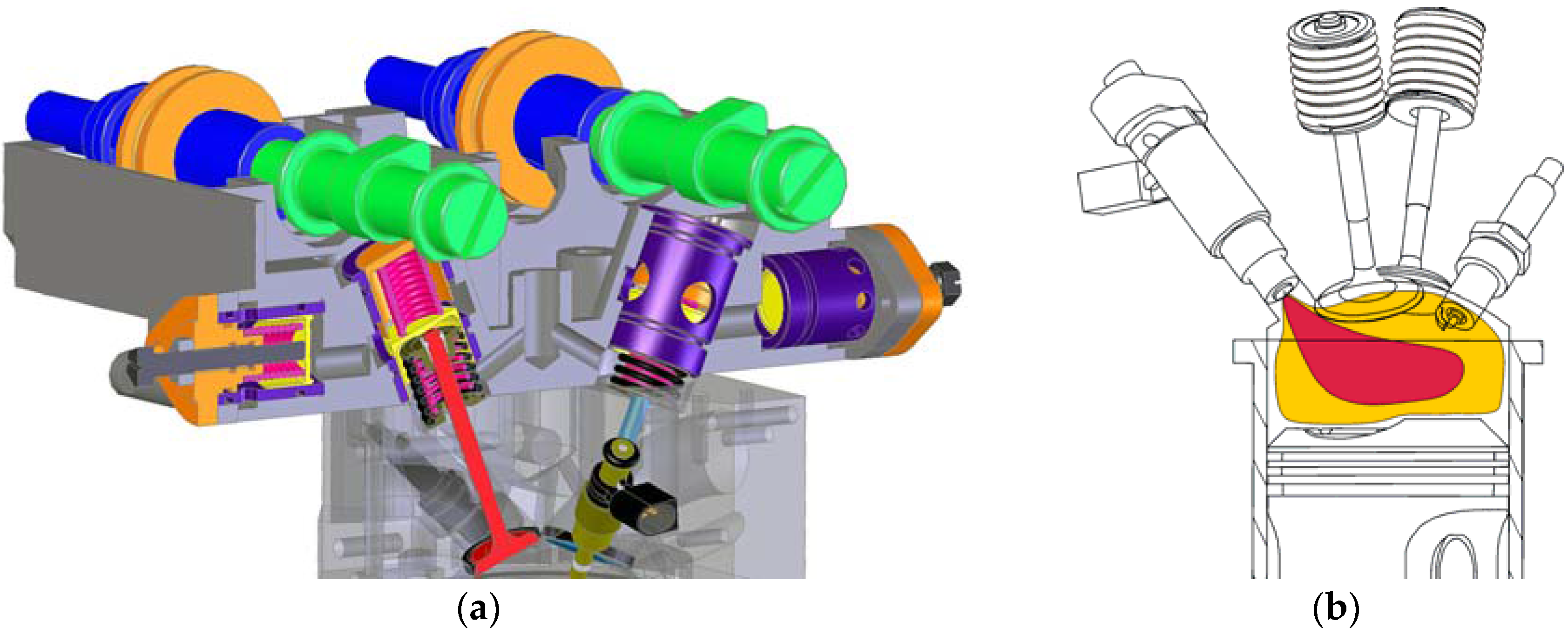

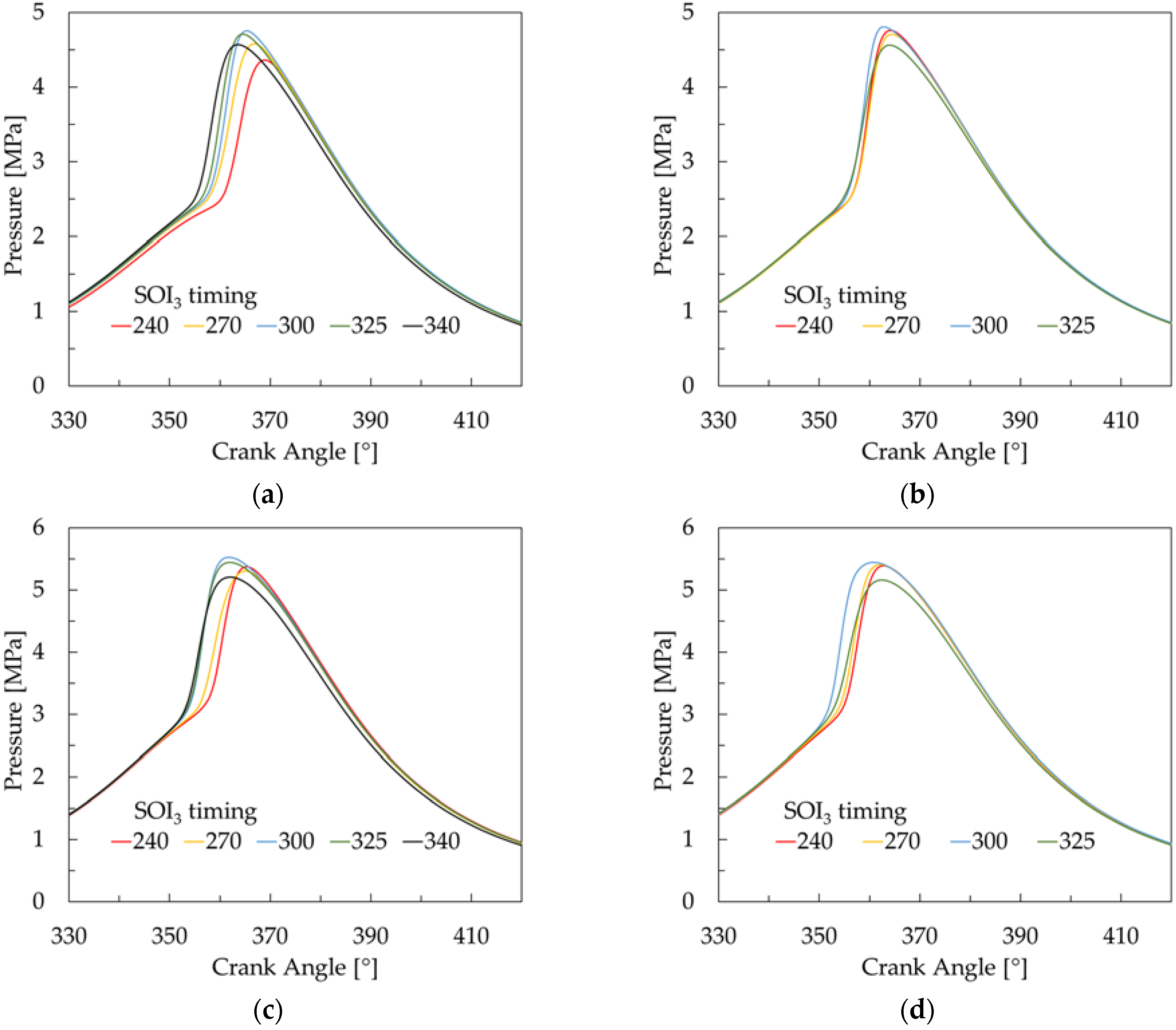
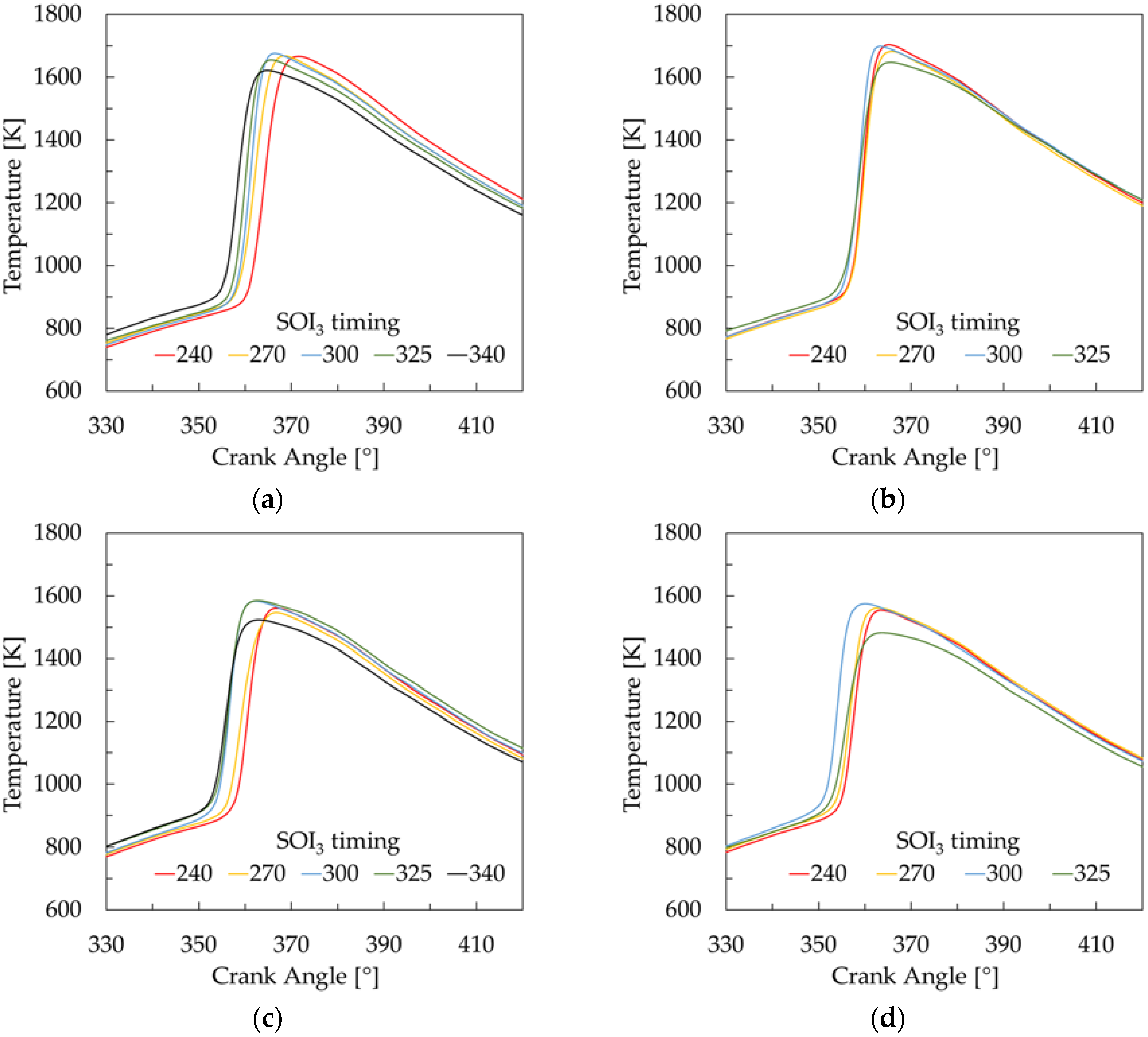
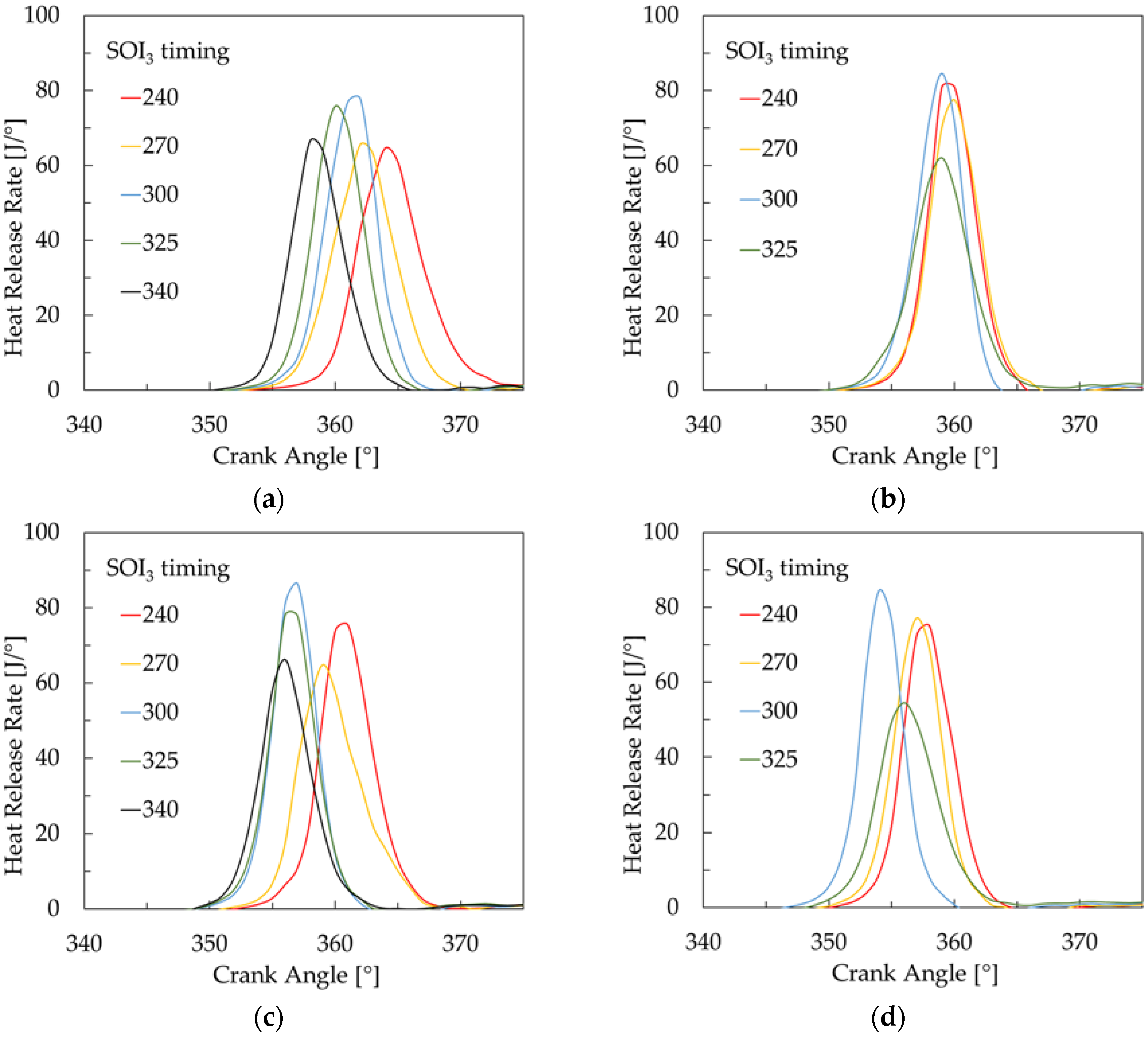
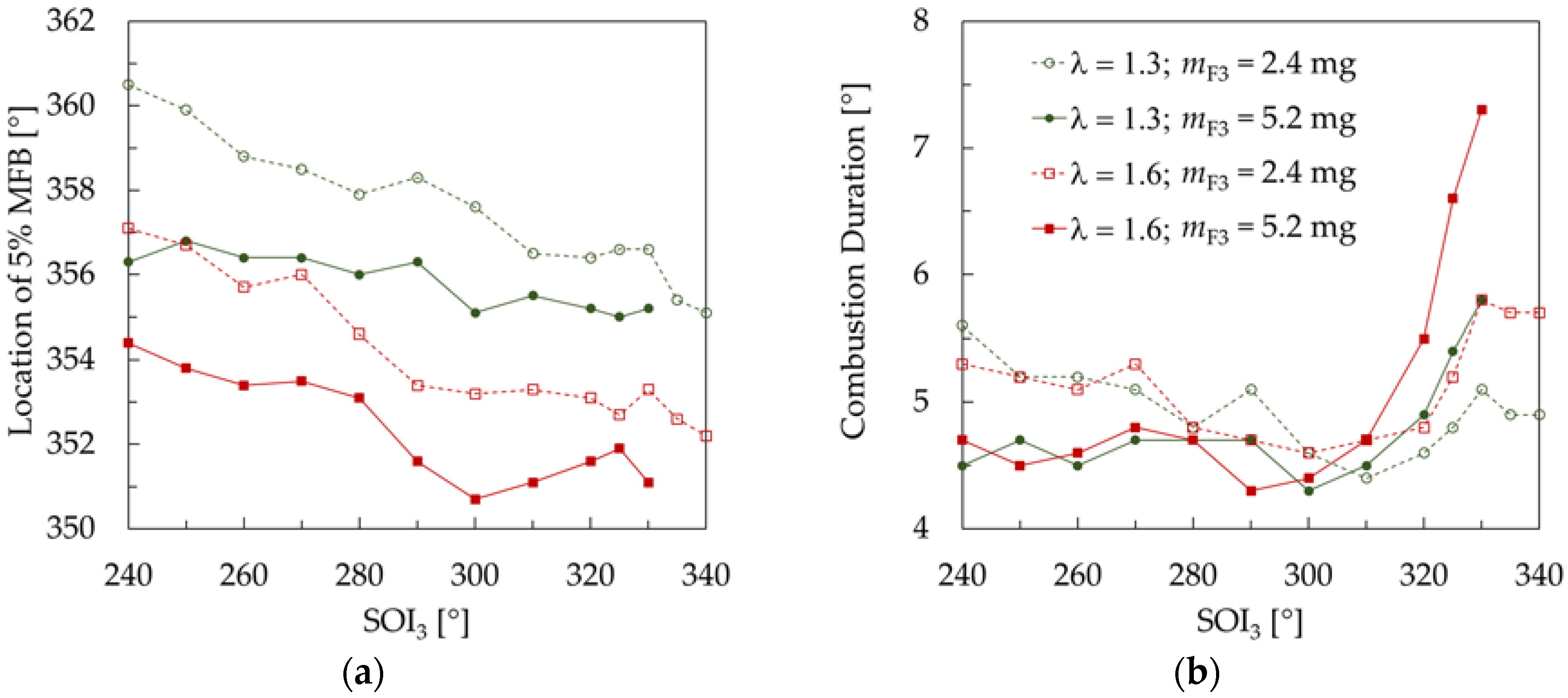
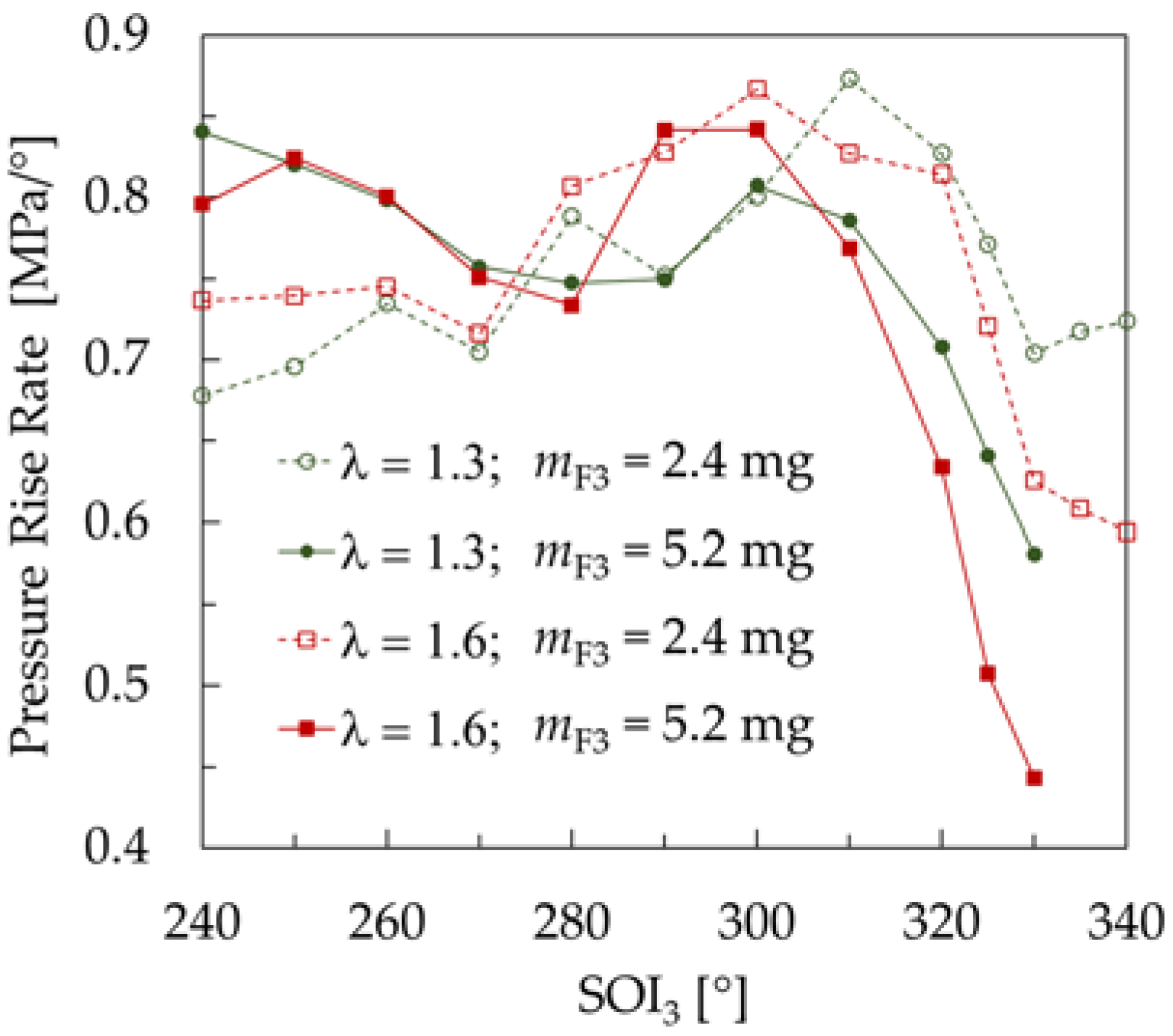
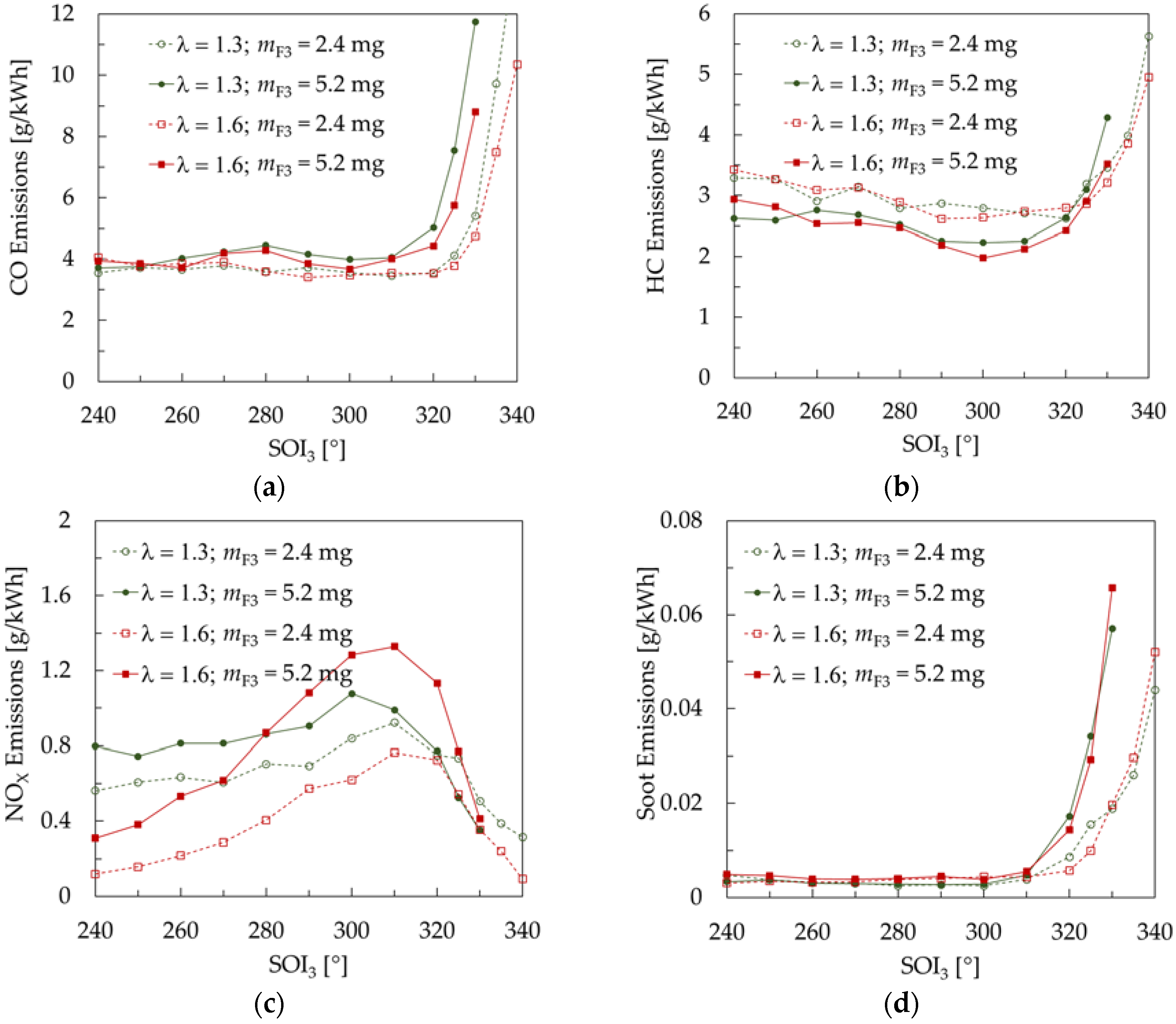
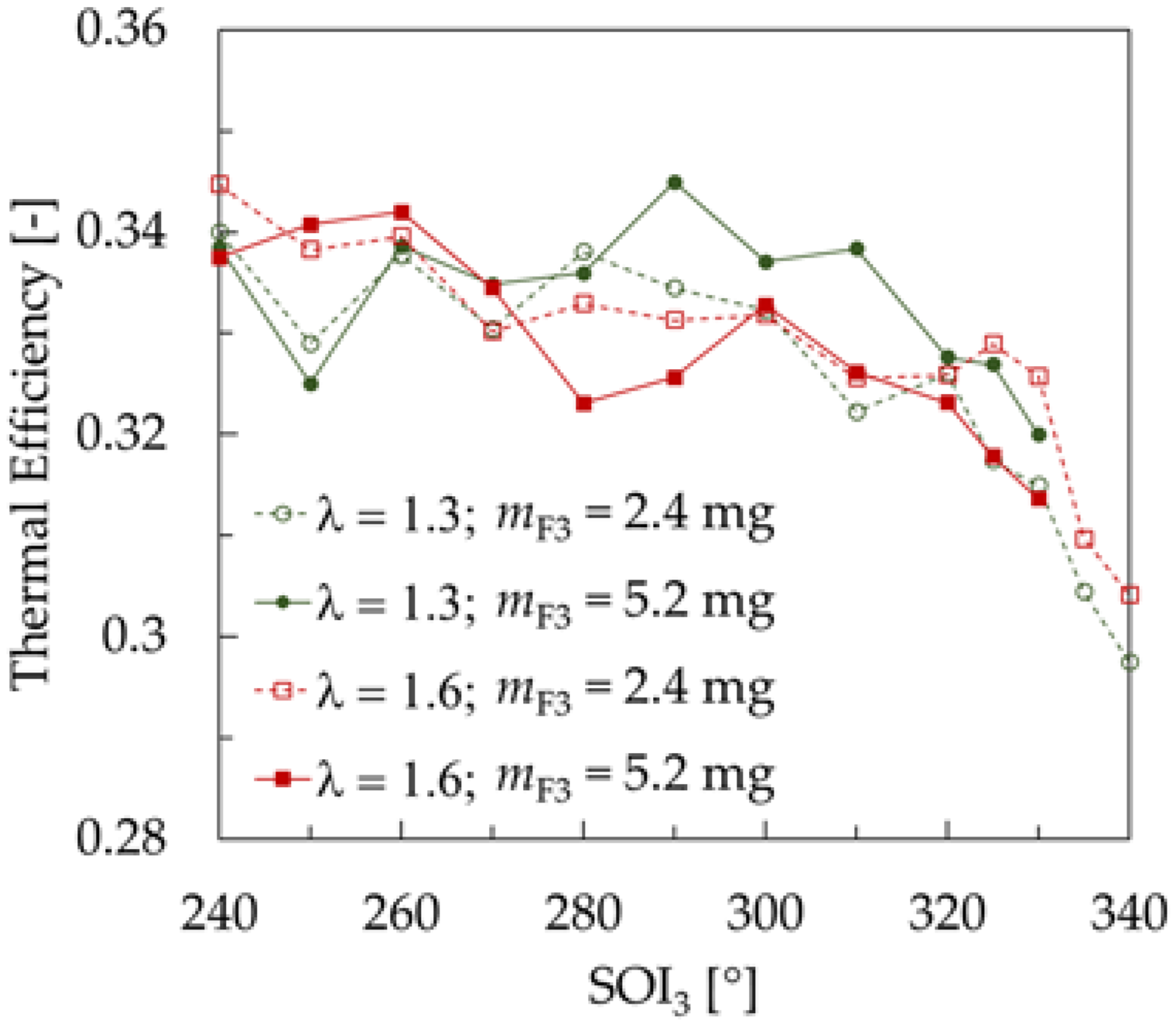
| Parameter | Value |
|---|---|
| Displaced volume | 498.5 cm3 |
| Bore | 84 mm |
| Stroke | 90 mm |
| Compression ratio | 11.7 |
| Number of valves | 2 |
| Intake cam profile | 9.4 mm, 235 °C A |
| Intake valve lift | 2.4 ... 9.4 mm |
| Exhaust cam profile | 9.2 mm, 235 °C A |
| Exhaust valve lift | 2.2 ... 9.2 mm |
© 2017 by the authors. Licensee MDPI, Basel, Switzerland. This article is an open access article distributed under the terms and conditions of the Creative Commons Attribution (CC BY) license (http://creativecommons.org/licenses/by/4.0/).
Share and Cite
Hunicz, J.; Tmar, A.; Krzaczek, P. Effects of Mixture Stratification on Combustion and Emissions of Boosted Controlled Auto-Ignition Engines. Energies 2017, 10, 2172. https://doi.org/10.3390/en10122172
Hunicz J, Tmar A, Krzaczek P. Effects of Mixture Stratification on Combustion and Emissions of Boosted Controlled Auto-Ignition Engines. Energies. 2017; 10(12):2172. https://doi.org/10.3390/en10122172
Chicago/Turabian StyleHunicz, Jacek, Aymen Tmar, and Paweł Krzaczek. 2017. "Effects of Mixture Stratification on Combustion and Emissions of Boosted Controlled Auto-Ignition Engines" Energies 10, no. 12: 2172. https://doi.org/10.3390/en10122172





